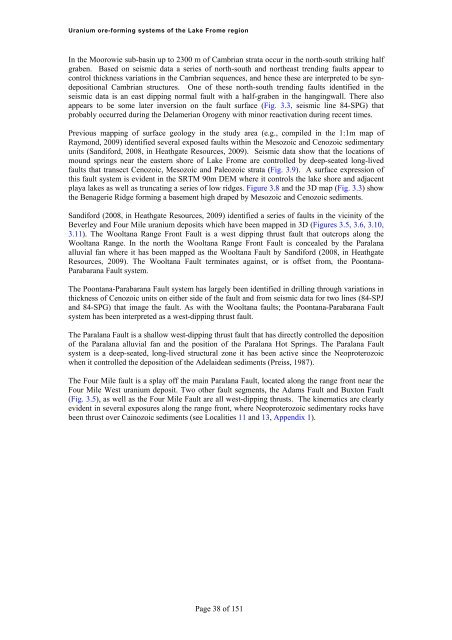Uranium ore-forming systems of the - Geoscience Australia
Uranium ore-forming systems of the - Geoscience Australia
Uranium ore-forming systems of the - Geoscience Australia
Create successful ePaper yourself
Turn your PDF publications into a flip-book with our unique Google optimized e-Paper software.
<strong>Uranium</strong> <strong>ore</strong>-<strong>forming</strong> <strong>systems</strong> <strong>of</strong> <strong>the</strong> Lake Frome regionIn <strong>the</strong> Moorowie sub-basin up to 2300 m <strong>of</strong> Cambrian strata occur in <strong>the</strong> north-south striking halfgraben. Based on seismic data a series <strong>of</strong> north-south and nor<strong>the</strong>ast trending faults appear tocontrol thickness variations in <strong>the</strong> Cambrian sequences, and hence <strong>the</strong>se are interpreted to be syndepositionalCambrian structures. One <strong>of</strong> <strong>the</strong>se north-south trending faults identified in <strong>the</strong>seismic data is an east dipping normal fault with a half-graben in <strong>the</strong> hangingwall. There alsoappears to be some later inversion on <strong>the</strong> fault surface (Fig. 3.3, seismic line 84-SPG) thatprobably occurred during <strong>the</strong> Delamerian Orogeny with minor reactivation during recent times.Previous mapping <strong>of</strong> surface geology in <strong>the</strong> study area (e.g., compiled in <strong>the</strong> 1:1m map <strong>of</strong>Raymond, 2009) identified several exposed faults within <strong>the</strong> Mesozoic and Cenozoic sedimentaryunits (Sandiford, 2008, in Heathgate Resources, 2009). Seismic data show that <strong>the</strong> locations <strong>of</strong>mound springs near <strong>the</strong> eastern sh<strong>ore</strong> <strong>of</strong> Lake Frome are controlled by deep-seated long-livedfaults that transect Cenozoic, Mesozoic and Paleozoic strata (Fig. 3.9). A surface expression <strong>of</strong>this fault system is evident in <strong>the</strong> SRTM 90m DEM where it controls <strong>the</strong> lake sh<strong>ore</strong> and adjacentplaya lakes as well as truncating a series <strong>of</strong> low ridges. Figure 3.8 and <strong>the</strong> 3D map (Fig. 3.3) show<strong>the</strong> Benagerie Ridge <strong>forming</strong> a basement high draped by Mesozoic and Cenozoic sediments.Sandiford (2008, in Heathgate Resources, 2009) identified a series <strong>of</strong> faults in <strong>the</strong> vicinity <strong>of</strong> <strong>the</strong>Beverley and Four Mile uranium deposits which have been mapped in 3D (Figures 3.5, 3.6, 3.10,3.11). The Wooltana Range Front Fault is a west dipping thrust fault that outcrops along <strong>the</strong>Wooltana Range. In <strong>the</strong> north <strong>the</strong> Wooltana Range Front Fault is concealed by <strong>the</strong> Paralanaalluvial fan where it has been mapped as <strong>the</strong> Wooltana Fault by Sandiford (2008, in HeathgateResources, 2009). The Wooltana Fault terminates against, or is <strong>of</strong>fset from, <strong>the</strong> Poontana-Parabarana Fault system.The Poontana-Parabarana Fault system has largely been identified in drilling through variations inthickness <strong>of</strong> Cenozoic units on ei<strong>the</strong>r side <strong>of</strong> <strong>the</strong> fault and from seismic data for two lines (84-SPJand 84-SPG) that image <strong>the</strong> fault. As with <strong>the</strong> Wooltana faults; <strong>the</strong> Poontana-Parabarana Faultsystem has been interpreted as a west-dipping thrust fault.The Paralana Fault is a shallow west-dipping thrust fault that has directly controlled <strong>the</strong> deposition<strong>of</strong> <strong>the</strong> Paralana alluvial fan and <strong>the</strong> position <strong>of</strong> <strong>the</strong> Paralana Hot Springs. The Paralana Faultsystem is a deep-seated, long-lived structural zone it has been active since <strong>the</strong> Neoproterozoicwhen it controlled <strong>the</strong> deposition <strong>of</strong> <strong>the</strong> Adelaidean sediments (Preiss, 1987).The Four Mile fault is a splay <strong>of</strong>f <strong>the</strong> main Paralana Fault, located along <strong>the</strong> range front near <strong>the</strong>Four Mile West uranium deposit. Two o<strong>the</strong>r fault segments, <strong>the</strong> Adams Fault and Buxton Fault(Fig. 3.5), as well as <strong>the</strong> Four Mile Fault are all west-dipping thrusts. The kinematics are clearlyevident in several exposures along <strong>the</strong> range front, where Neoproterozoic sedimentary rocks havebeen thrust over Cainozoic sediments (see Localities 11 and 13, Appendix 1).Page 38 <strong>of</strong> 151
















